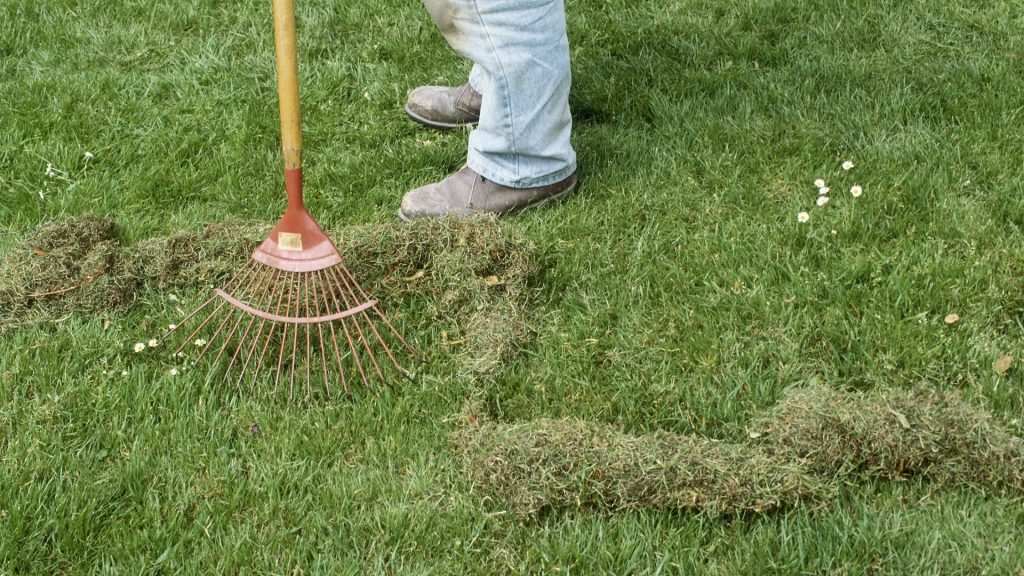
How To Use A Power Rake
Thatch is something you don’t want in your lawn in large amounts. This is decaying organic material that forms on top of your grass, and if there’s more than half an inch of it present it will stop your grass from getting nutrients and sunlight. This can damage or kill it, so you need to use the correct tool to remove thatch.
What tool should you use to dethatch your lawn? You should use a power rake to remove thatch. This is a machine with blades that pulls up and removes debris and thatch.
While you might think that a regular garden rake can be enough to remove thatch, this tool isn’t strong enough. A power rake will also make the process so much easier. With this in mind, let’s explore how to use a power rake.
Tips For Using A Power Rake

- Switch your power rake on. It has an on/off switch and pull start just like a lawnmower.
- You want to set the deck of your power rake to high by pulling up the lever on the side.
- Do a pass across your lawn so that you can do a test run. You’ll see how much of the thatch you’ll be able to remove at this deck height, and if you’ve never used a power rake before this will give you a chance to test it out for yourself.
- You should then do a pass at a lower setting to see the differences. Be wary of ripping out green grass and roots as this is what you want to avoid.
- Adjust the depth of the flails (flat discs underneath the machine that spin fast to remove debris) on the power rake so that they make contact with the thatch to be able to remove it, but the flails shouldn’t make contact with the soil.
- For best results when power raking your lawn, you should work in rows. Start at the bottom of your lawn and go all the way up, then turn at the top and use the power rake all the way down in the next row.
- After using your power rake, you have to collect the debris that’s leftover with a mower or lawn rake. It’s probably best to use a lawn rake to remove the thatch that’s been pulled up because it will be faster than using a lawnmower unless you have a ride-on lawnmower with a large bag capacity.
- While you might think you’re finished with your task at this point, you’re not. Once you’ve cleaned up the thatch, you should use your power rake again. This time, you should use it in the opposite direction so that you ensure you pull up and uproot all the dead debris that’s present in your lawn.
- Then, clean up the thatch that’s been pulled up with a lawn rake.
When Should You Use A Power Rake To Remove Thatch?

If the thatch on your lawn is thicker than half an inch, there’s enough for you to power rake. This will ensure you keep your grass healthy and well maintained.
To find out if you’re dealing with half an inch of thatch, you will have to take a core sample of soil and grass. Measure the organic material that’s on the surface of the soil. If it’s thicker than half an inch, then you’re good to go.
Note that thatch looks like felt, it’s reddish-brown in color, and it’s found between the grass and soil.
When Is The Best Time To Power Rake Your Lawn?

The best time when you should power rake your lawn depends on whether you have warm-season or cool-season grass.
- If you have warm-season grass, you should power rake it during the late spring or early summer.
- If you have cool-season grass, you should power rake your lawn in early fall or during spring.
Since power raking can damage some grass, you shouldn’t power rake your lawn outside of these times of the year. This is because it can damage your lawn because you’ll be removing grass during its growing season.
What Should You Do After Dethatching Your Lawn?

Dethatching can be traumatic and stressful for your lawn, so you have to give it some TLC. This should take the form of deeply drenching it with water to encourage root growth to the lower levels of the soil where moisture sticks around for longer than it does on the surface.
Now’s also the perfect time to overseed your lawn so it can grow thicker and look greener.
Related Questions
Should you fertilize your lawn after dethatching it?

Fertilizing is a good idea, especially if you want to overseed your lawn so that new grass can grow.
How can you prevent too much thatch from causing you future problems?
You should conduct soil tests every three or four years, following recommendations to keep the pH of your soil and the nutrients it requires at healthy levels. This promotes microorganism growth, which reduces thatch.
Conclusion
If your lawn is filled with thatch, you should remove it. To do this, you can rent a power rake, a machine that effectively pulls up and removes thatch so your lawn can be healthier.
Keep your lawn healthy and full of nutrition so that it can be green and healthy without harmful thatch getting in the way.
Resources:

